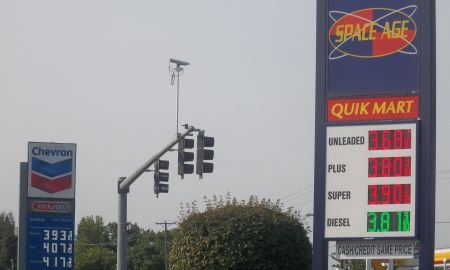Salem, Oregon Gas Prices Continue to Fall; Still 3rd Most Expensive U.S. Prices
Only drivers in Hawaii and Alaska are paying more at the pump.

(SALEM, Ore. ) — The average price for a gallon of regular unleaded gasoline in the Salem-Keizer area remained at $3.85 again this week, however for the second week in a row, Oregon has the most expensive gasoline in the 48 contiguous states.
In Portland-Vancouver the average price over the past week has dropped 2-cents to $3.87; in Eugene-Springfield the price fell one cent to $3.85; and in Medford-Ashland the price also dropped one cent to $3.87.
For the week, the national average for regular unleaded falls one-and-a-half cents to $3.43 while Oregon’s average edges down a penny to $3.89 per gallon.” AAA Oregon/Idaho Public Affairs Director Marie Dodds says, “The national average is at its lowest price since February of this year. The Oregon average is at its lowest price since late May. Drivers in the Pacific states continue to pay the highest retail prices in the nation for regular unleaded, however prices in each of these states have ticked down in the last week. The top five most expensive states are Hawaii, Alaska, Oregon, Washington and California. Drivers in South Carolina are paying the least per gallon at $3.15, a savings of $1.15 compared to drivers in Hawaii.”
A couple factors have kept pump prices in the Pacific region higher than in other parts of the country. First of all, this region is somewhat geographically isolated from the cheaper crude oil products that are available in the central U.S. Secondly, refinery issues on the West Coast have kept supplies tight in this region, which kept pump prices elevated for much of the spring and summer. If there are no additional refinery or distribution issues in the region, drivers here should start to get some relief in the coming weeks.
September 15 starts the shift to the winter blend gasoline from the more expensive summer blend gasoline. Demand normally drops off after Labor Day when the kids go back to school and the busy summer driving season comes to an end. Pump prices typically fall during this time.
Oregon is one of 44 states and Washington D.C. where gas prices have gone down in the last week with the largest savings in Illinois (-6 cents) and Pennsylvania (-5 cents).
Oregon is one of only seven states where gas prices are more expensive now than a year ago. The largest year-over-year increases are reported in Nevada and Oregon, where drivers in both states are paying 16 cents more than a year ago.
Both the Oregon and national averages are below their year-to-date highs. The national average peaked at $3.70 a gallon on April 28. Oregon’s average reached its 2014 high of $3.99 on July 3.
Geopolitical tensions remain top of mind, including in Iraq where the jihadist group known as ISIL (Islamic State of Iraq and the Levant) took responsibility for the death of an American journalist. The Obama Administration is exploring expanding military action in the region, and the potential for disruptions in supply remains front of mind for market watchers. In recent years, violence and unrest in the Middle East has triggered higher global crude oil prices and ultimately higher prices at the pump; however this has not been the case this summer.
In recent weeks, oil markets have largely shrugged off reports of violence and tensions overseas and have instead moved steadily lower as analysts have assessed the potential for a disruption in oil supplies to be limited. This is largely due to the relative stability of global supply projections, attributed to the U.S. approaching its highest annual level of oil production since 1972 and Libya’s returning to previous production levels.
South Carolina is now just 15 cents away from $3. Hawaii has the most expensive gas in the country for the 96th consecutive week at $4.30, followed by Alaska at $4.07, Oregon at $3.89 (down a penny and third most expensive for the second consecutive week), Washington at $3.88 (down two cents and fourth for the second week in a row), and California at $3.87 (down a penny and fifth for the second consecutive week). Idaho is sixth up from seventh last week at $3.77 (same price as last week). South Carolina has the cheapest gas in the country for the 10th week in a row at $3.15 a gallon (same price as last week).
Diesel prices are ticking down or holding steady in most markets.
The national average slips a penny to $3.81 a gallon. Oregon’s remains at $3.93. Diesel is at or above $4 a gallon in six states for the third week in a row. Hawaii is most expensive at $4.87, followed by Connecticut at $4.16, Alaska at $4.15, New York at $4.14, and California at $4.10 (same price as last week). Washington is sixth for the fourth consecutive week at $4.01 (same price as last week). Idaho is 10th up from 11th at $3.94 (up a penny). Oregon is 11th down from 10th last week. A year ago, the national average for diesel was $3.88 and Oregon's was $3.89.
Sources: AAA Oregon; AAA Fuel Gauge Report



